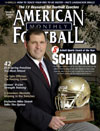AMERICAN FOOTBALL MONTHLY THE #1 RESOURCE FOR FOOTBALL COACHES
Article CategoriesAFM Magazine
|
Building a FoundationRutgers\' Greg Schiano has transformed the scarlet knights into one of the nation\'s best programsby: Richard Scott © More from this issue Despite having played in the nation’s first college football game on Nov. 6, 1869, Rutgers’ transformation from perennial loser to winner did not begin until Greg Schiano took over as the Scarlet Knights’ head coach on Dec. 1, 2000. Even then, success didn’t come immediately. Over a six-year period, the program and the coaching staff’s strategies and philosophies have undergone a series of adjustments and adaptations. “Being a defensive coach I’ve always believed in trying to make the offense play you,” Schiano said, “but that’s not always so easy to do with all the multiple formations and the things people do. They can get you in a situation where you’re kind of on your heels. Our defensive scheme had to be complex, hopefully, for the offense but simple enough for the defensive kids.” From his playing days a....The full article can only be seen by subscribers. Subscribe today!
|
|
|||||||
| HOME |
MAGAZINE |
SUBSCRIBE | ONLINE COLUMNISTS | COACHING VIDEOS |
Copyright 2025, AmericanFootballMonthly.com
All Rights Reserved





